Django APIView源码解析
APIView使用:luffy项目中关于APIView的使用
在Django之 CBV和FBV中,我们是分析的from django.views import View下的执行流程,以下是代码
from django.views import View
class IndexView(View):
def get(self,request, *args, **kwargs):
return HttpResponse("ok") def dispatch(self, request, *args, **kwargs):
ret = super(IndexView,self).dispatch(request, *args, **kwargs) return HttpResponse(ret)
这篇博客我们就来了解下APIView是如何执行的,跟django.views模块下的view有何关联?
from rest_framework.views import APIView
我们依然从url配置入手分析
url(r"books/$",views.BookView.as_view())
as_view方法代码如下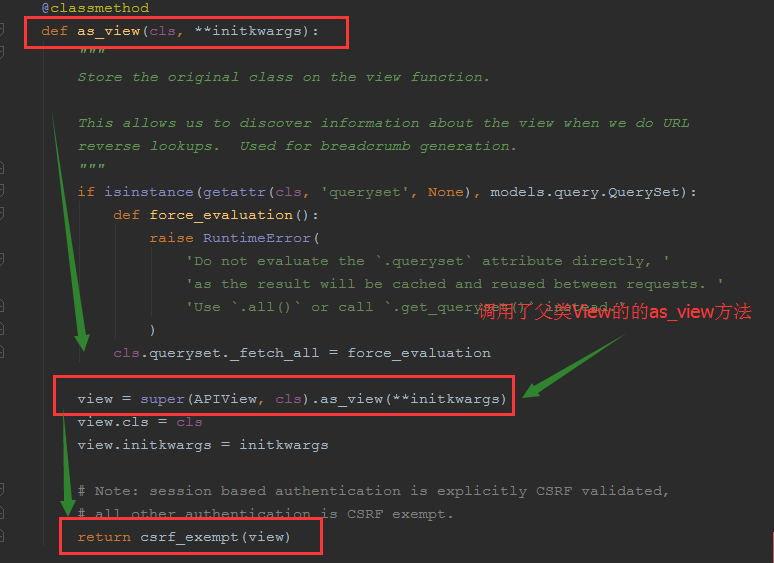
原来APIView类是继承View类,view类正式from django.views import View下的View,
先看as_view方法中的view = super(APIView, cls).as_view(**initkwargs)的这行代码,
是调用了父类View中的as_view方法,这里的initkwargs,及其父类的View中的as_view方法执行流程,之类就不在赘述了
具体流程去看我的博客链接
https://www.cnblogs.com/95lyj/p/9432750.html
所以在APIView类中,我们重点看下return csrf_exempt(view)做了什么操作?
def csrf_exempt(view_func):
def wrapped_view(*args, **kwargs):
return view_func(*args, **kwargs)
wrapped_view.csrf_exempt = True
return wraps(view_func, assigned=available_attrs(view_func))(wrapped_view)
wrapped_view.csrf_exempt = True意思是取消当前函数防跨站请求伪造功能,即便settings中设置了全局中间件,然后将csrf_exempt函数中的内置函数wrapped_view赋值wrapped_view.csrf_exempt = True,使其拥有该属性,
接下来看 wraps(view_func, assigned=available_attrs(view_func))(wrapped_view)函数之前,
我们先看下assigned=available_attrs(view_func)
def available_attrs(fn):
if six.PY3:
return WRAPPER_ASSIGNMENTS
else:
return tuple(a for a in WRAPPER_ASSIGNMENTS if hasattr(fn, a))
大概意思就是针对py3或者其他版本做了一些判断处理,最后通过WRAPPER_ASSIGNMENTS定为到
WRAPPER_ASSIGNMENTS = ('__module__', '__name__', '__qualname__', '__doc__',
'__annotations__')
这个逻辑跟我们上一篇的CBV源码有共同之处,就是为某个方法或者函数,添加某些属性
接下来我们看wraps函数吧
def wraps(wrapped,
assigned = WRAPPER_ASSIGNMENTS,
updated = WRAPPER_UPDATES):
return partial(update_wrapper, wrapped=wrapped,
assigned=assigned, updated=updated)
wrapped是我们在def csrf_exempt(view_func):函数中的参数,也就是as_view的返回值,
最后通过functools模块下的partial类进行装饰构造,partial 这个东西是针对函数起作用的,并且是部分的,
场景:有这样的函数:get_useragent(request) 用来获取用户浏览器的ua信息,但是这个函数又不是在主体函数(执行页面渲染的函数)get时调用的,只在模板中的一个filter中调用的(可以理解是在模板渲染时调用的),而filter在执行的时候是不能添加参数的,哪你要怎么处理。
这时partial就得闪亮登场,如下是代码,
def __new__(*args, **keywords):
if not args:
raise TypeError("descriptor '__new__' of partial needs an argument")
if len(args) < 2:
raise TypeError("type 'partial' takes at least one argument")
cls, func, *args = args
if not callable(func):
raise TypeError("the first argument must be callable")
args = tuple(args) if hasattr(func, "func"):
args = func.args + args
tmpkw = func.keywords.copy()
tmpkw.update(keywords)
keywords = tmpkw
del tmpkw
func = func.func self = super(partial, cls).__new__(cls) self.func = func
self.args = args
self.keywords = keywords
return self def __call__(*args, **keywords):
if not args:
raise TypeError("descriptor '__call__' of partial needs an argument")
self, *args = args
newkeywords = self.keywords.copy()
newkeywords.update(keywords)
return self.func(*self.args, *args, **newkeywords)
最后在csrf_exempt函数中的wraps(view_func, assigned=available_attrs(view_func))(wrapped_view)这里写代码片传入参数wrapped_view,通过对象可调用功能,进行调用__call__方法
到此as_view分析完毕,以上代码好多有迷惑的点,我分析的时候也是很多猜想的
上篇CBV源码分析中我们知道,当as_view执行后,当浏览器访问某个api接口时候,
就会先触发dispatch,然后在dispatch中,如下是父类的dispatch方法
def dispatch(self, request, *args, **kwargs):
# Try to dispatch to the right method; if a method doesn't exist,
# defer to the error handler. Also defer to the error handler if the
# request method isn't on the approved list. if request.method.lower() in self.http_method_names:
handler = getattr(self, request.method.lower(), self.http_method_not_allowed)
else:
handler = self.http_method_not_allowed return handler(request, *args, **kwargs)
然而API方法中也有自己的dispatch方法,会执行子类的方法,而不是去执行父类的dispatch方法,以下是代码
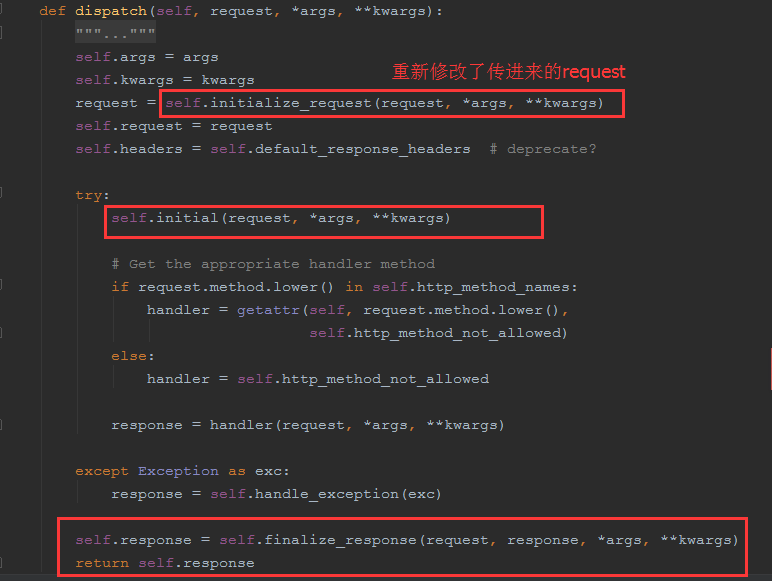
以上dispatch方法中,通过self.initialize_request(request, *args, **kwargs)
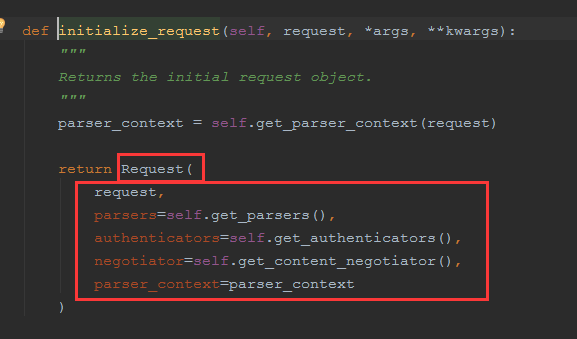
def initialize_request(self, request, *args, **kwargs):
"""
Returns the initial request object.
"""
#将请求变成字典格式返回了
parser_context = self.get_parser_context(request) return Request(
request,
parsers=self.get_parsers(), #解析数据,默认的有三种方式,可点进去看
#self.get_authenticator优先找自己的,没有就找父类的
authenticators=self.get_authenticators(), #获取认证相关的所有类并实例化,传入request对象供Request使用
negotiator=self.get_content_negotiator(),
parser_context=parser_context
)
通过initialize_request的到一个Request类对象
在这过程中:
1、获取认证相关的类的具体 authenticators=self.get_authenticators(),
def get_authenticators(self):
"""
Instantiates and returns the list of authenticators that this view can use.
"""
#返回的是对象列表
return [auth() for auth in self.authentication_classes] #[SessionAuthentication,BaseAuthentication]
2、查看认证的类:self.authentication_classes
authentication_classes = api_settings.DEFAULT_AUTHENTICATION_CLASSES #默认的,如果自己有会优先执行自己的
3、接着走进api_settings
api_settings = APISettings(None, DEFAULTS, IMPORT_STRINGS) #点击继承的DEFAULTS类
DEFAULTS = {
# Base API policies
'DEFAULT_AUTHENTICATION_CLASSES': (
'rest_framework.authentication.SessionAuthentication', #这时候就找到了他默认认证的类了,可以导入看看
'rest_framework.authentication.BasicAuthentication'
),
4、导入了类看看类里面具体干了什么
from rest_framework.authentication import SessionAuthentication
from rest_framework.authentication import BaseAuthentication
5、看到里面有个authenticate方法和authenticate_header方法
class BaseAuthentication(object):
"""
All authentication classes should extend BaseAuthentication.
""" def authenticate(self, request):
"""
Authenticate the request and return a two-tuple of (user, token).
"""
raise NotImplementedError(".authenticate() must be overridden.") def authenticate_header(self, request):
"""
Return a string to be used as the value of the `WWW-Authenticate`
header in a `401 Unauthenticated` response, or `None` if the
authentication scheme should return `403 Permission Denied` responses.
"""
pass
6、具体处理认证,从headers里面能获取用户名和密码
class BasicAuthentication(BaseAuthentication):
"""
HTTP Basic authentication against username/password.
"""
www_authenticate_realm = 'api' def authenticate(self, request):
"""
Returns a `User` if a correct username and password have been supplied
using HTTP Basic authentication. Otherwise returns `None`.
"""
auth = get_authorization_header(request).split() if not auth or auth[0].lower() != b'basic':
return None #返回none不处理。让下一个处理 if len(auth) == 1:
msg = _('Invalid basic header. No credentials provided.')
raise exceptions.AuthenticationFailed(msg)
elif len(auth) > 2:
msg = _('Invalid basic header. Credentials string should not contain spaces.')
raise exceptions.AuthenticationFailed(msg) try:
auth_parts = base64.b64decode(auth[1]).decode(HTTP_HEADER_ENCODING).partition(':') #用partition切割冒号也包括
except (TypeError, UnicodeDecodeError, binascii.Error):
msg = _('Invalid basic header. Credentials not correctly base64 encoded.')
raise exceptions.AuthenticationFailed(msg) userid, password = auth_parts[0], auth_parts[2] # 返回用户和密码
return self.authenticate_credentials(userid, password, request) def authenticate_credentials(self, userid, password, request=None):
"""
Authenticate the userid and password against username and password
with optional request for context.
"""
credentials = {
get_user_model().USERNAME_FIELD: userid,
'password': password
}
user = authenticate(request=request, **credentials) if user is None:
raise exceptions.AuthenticationFailed(_('Invalid username/password.')) if not user.is_active:
raise exceptions.AuthenticationFailed(_('User inactive or deleted.')) return (user, None) def authenticate_header(self, request):
return 'Basic realm="%s"' % self.www_authenticate_realm
当然restfulframework默认定义了两个类。我们也可以自定制类,自己有就用自己的了,自己没有就去找父类的了,但是里面必须实现authenticate方法,不然会报错。
然后self.initial(request, *args, **kwargs),
- 处理版权信息
- 认证
- 权限
- 请求用户进行访问频率的限制
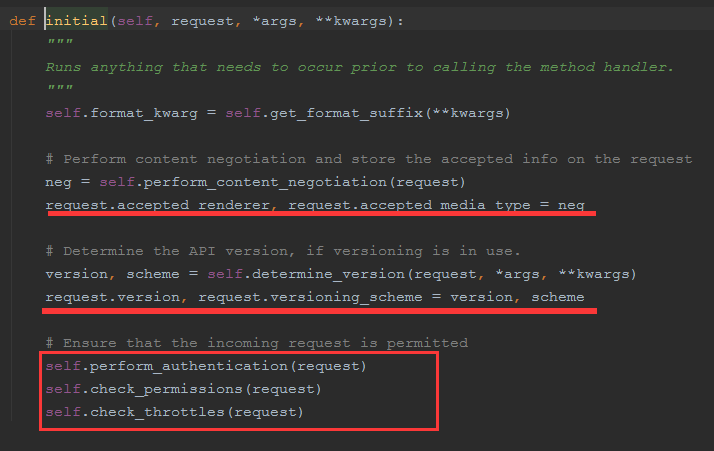
1、首先 self.initial(request, *args, **kwargs)可以看到做了以下操作
def initial(self, request, *args, **kwargs):
"""
Runs anything that needs to occur prior to calling the method handler.
"""
self.format_kwarg = self.get_format_suffix(**kwargs) # Perform content negotiation and store the accepted info on the request
neg = self.perform_content_negotiation(request)
request.accepted_renderer, request.accepted_media_type = neg # Determine the API version, if versioning is in use.
#2.1 处理版本信息
version, scheme = self.determine_version(request, *args, **kwargs)
request.version, request.versioning_scheme = version, scheme # Ensure that the incoming request is permitted
#2.2 认证
self.perform_authentication(request)
# 2.3 权限
self.check_permissions(request)
# 2.4 请求用户进行访问频率的限制
self.check_throttles(request)
2、我们先来看认证,self.perform_authentication(request) 具体干了什么,按住ctrl点击进去
def perform_authentication(self, request):
"""
Perform authentication on the incoming request. Note that if you override this and simply 'pass', then authentication
will instead be performed lazily, the first time either
`request.user` or `request.auth` is accessed.
"""
request.user #执行request的user,这是的request已经是加工后的request了
3、那么我们可以从视图里面导入一下Request,找到request对象的user方法
from rest_framework.views import Request
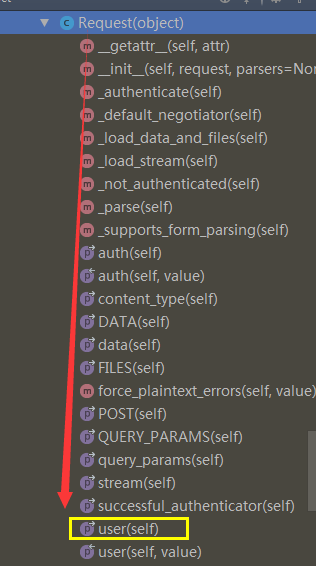
@property
def user(self):
"""
Returns the user associated with the current request, as authenticated
by the authentication classes provided to the request.
"""
if not hasattr(self, '_user'):
with wrap_attributeerrors():
self._authenticate() #
return self._user #返回user
4、执行self._authenticate() 开始用户认证,如果验证成功后返回元组: (用户,用户Token)
def _authenticate(self):
"""
Attempt to authenticate the request using each authentication instance
in turn.
"""
#循环对象列表
for authenticator in self.authenticators:
try:
#执行每一个对象的authenticate 方法
user_auth_tuple = authenticator.authenticate(self)
except exceptions.APIException:
self._not_authenticated()
raise if user_auth_tuple is not None:
self._authenticator = authenticator
self.user, self.auth = user_auth_tuple #返回一个元组,user,和auth,赋给了self,
# 只要实例化Request,就会有一个request对象,就可以request.user,request.auth了
return self._not_authenticated()
5、在user_auth_tuple = authenticator.authenticate(self) 进行验证,如果验证成功,执行类里的authenticatie方法
6、如果用户没有认证成功:self._not_authenticated()
def _not_authenticated(self):
"""
Set authenticator, user & authtoken representing an unauthenticated request. Defaults are None, AnonymousUser & None.
"""
#如果跳过了所有认证,默认用户和Token和使用配置文件进行设置
self._authenticator = None # if api_settings.UNAUTHENTICATED_USER:
self.user = api_settings.UNAUTHENTICATED_USER() # 默认值为:匿名用户AnonymousUser
else:
self.user = None # None 表示跳过该认证 if api_settings.UNAUTHENTICATED_TOKEN:
self.auth = api_settings.UNAUTHENTICATED_TOKEN() # 默认值为:None
else:
self.auth = None # (user, token)
# 表示验证通过并设置用户名和Token;
# AuthenticationFailed异常
完善request请求的一些注意事项,例如用户登录、检测权限等等
然后response = handler(request, *args, **kwargs)这里面是执行了对应的请求操作,如get\post请求,也就是执行了我们自定义视图里面的get方法等,在处理完毕后,赋值response然后作为参数进行如下的操作
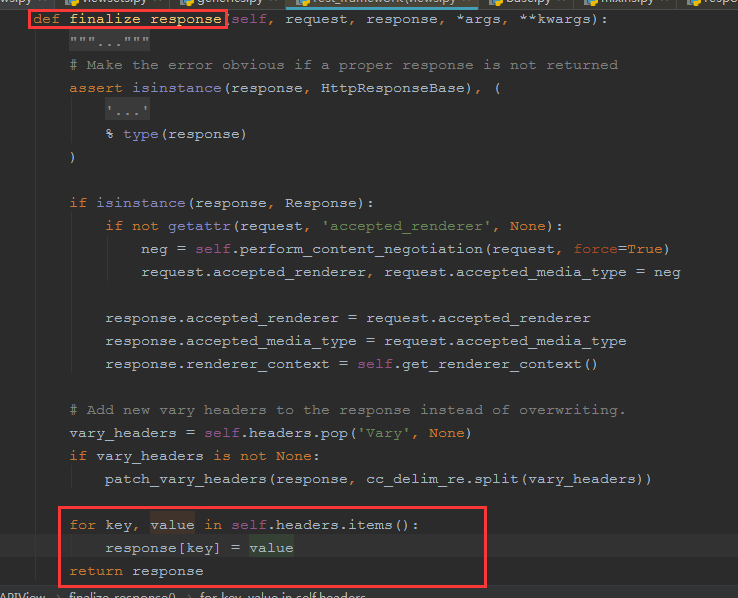
随后self.response = self.finalize_response(request, response, *args, **kwargs)返回,这一部操作,跟它的父类View是不同的,
在继承APIView的视图中,get\post需要返回HttpResponse,然后在通过self.finalize_response进一步封装,最后返回
最后在dispatch中
self.response = self.finalize_response(request, response, *args, **kwargs)
return self.response
Django APIView源码解析的更多相关文章
- DRF之APIView源码解析
目录 Django项目中的代码如下 APIView源码解析 源码解析总结 Django项目中的代码如下 urls.py中: from django.conf.urls import url from ...
- CBV源码与APIView源码解析
一.CBV源码解析 在我们写cbv的时候在url中和fbv的区别就是是否调用了as_view()方法,所以关键入手点就是这个方法 @classonlymethod # 这是类的绑定方法,这个cls是我 ...
- django -admin 源码解析
admin源码解析 单例模式 单例模式(Singleton Pattern)是一种常用的软件设计模式,该模式的主要目的是确保某一个类只有一个实例存在.当你希望在整个系统中,某个类只能出现一个实例时,单 ...
- Django settings源码解析
Django settings源码 Django中有两个配置文件 局部配置:配置文件settings.py,即项目同名文件夹下的settings.py文件 全局配置:django内部全局的配置文件se ...
- APIView源码解析
1.首先安装pip install djangorestframework 2.导入from rest_framework.views import APIView class Courses(API ...
- Django-Filter源码解析一
Django Filter源码解析 最近在看Django-FIlter项目的源码,学习一下别人的开发思想: 整体介绍 首先,我从其中一个测试用例作为入口,开始了debug之路,一点一点的断点,分析它的 ...
- Django生命周期 URL ----> CBV 源码解析-------------- 及rest_framework APIView 源码流程解析
一.一个请求来到Django 的生命周期 FBV 不讨论 CBV: 请求被代理转发到uwsgi: 开始Django的流程: 首先经过中间件process_request (session等) 然后 ...
- 源码解析Django CBV的本质
Django CBV模式的源码解析 通常来说,http请求的本质就是基于Socket Django的视图函数,可以基于FBV模式,也可以基于CBV模式. 基于FBV的模式就是在Django的路由映射表 ...
- $Django cbv源码分析 djangorestframework框架之APIView源码分析
1 CBV的源码分析 #视图 class login (View): pass #路由 url(r'^books/$', views.login.as_view()) #阅读源码: #左侧工程栏--- ...
随机推荐
- 为hade增加model自动生成功能
大家好,我是轩脉刃. 我们写业务的时候和db接触是少不了的,那么要生成model也是少不了的,如何自动生成model,想着要给hade框架增加个这样的命令. 看了下网上的几个开源项目,最终聚焦在两个项 ...
- jquery-easyui环境的搭建及测试
对于软件开发者来说,一个良好的前端框架不仅能够使页面优美可观而且还能够大大的提高开发效率.提高系统整体界面的美观,框架将常用的功能封装完成,减少工作量.前端框架目前也比较多,小编本次主要介绍下easy ...
- 01网络编程(基础知识+OSI七层协议+TCP与UDP)
目录 01 网络编程 一.软件开发架构 1.1 CS架构 1.2 BS架构 二.网络理论前戏 2.1 简介 2.2 常见硬件 三.OSI七层协议(五层) 3.1 七层协议 3.2 五层协议 3.3 知 ...
- 4、Linux基础--系统目录
笔记 1.晨考 1.移动文件的命令 mv 2.删除文件的命令及其参数 rm 参数: -r : 递归删除 -f : 不提示删除 -i : 提示删除 3.复制文件的命令及其参数 cp 参数: -r : 递 ...
- Solution -「UR #21」「UOJ #632」挑战最大团
\(\mathcal{Description}\) Link. 对于简单无向图 \(G=(V,E)\),定义它是"优美"的,当且仅当 \[\forall\{a,b,c,d\ ...
- 暑假撸系统1-先把git后悔药准备好!
学校规定让暑假自己撸一款在线考试系统,其实的确需要一个款在线的考试系统系统,因为平时学校是使用Excel讲解选择题的.基于这个目标那么就话不多说.开干! 本来趁着项目想练练手,使用些新学习的技能看看, ...
- MySQL架构原理之运行机制
所谓运行机制即MySQL内部就如生产车间如何进行生产的.如下图: 1.建立连接,通过客户端/服务器通信协议与MySQL建立连接.MySQL客户端与服务端的通信方式是"半双工".对于 ...
- Xshell在Windows和Linux间文件的上传和下载
本文通过lrzsz来实现Windows和Linux间文件间的文件传输. lrzsz使用 XMODEM.YMODEM 和 ZMODEM 文件传输协议来实现文件的上传和下载.相比 FTP 或者 WinSC ...
- gurbi安装
1,下载相应版本gurobi,msi文件,双击安装.注意安装路径,一般默认,否则容易出错. 2,注册gurobi账号,在校园网下电脑终端运行许可grbgetkey 3,添加许可路径到系统path 4, ...
- Linux命令(ping-telnet-netstat-curl-ps)
转至:https://www.jianshu.com/p/577bbd15a6f8 1.ping命令 ping命令用来测试主机之间网络的连通性.执行ping指令会使用ICMP传输协议,发出要求回应的信 ...
